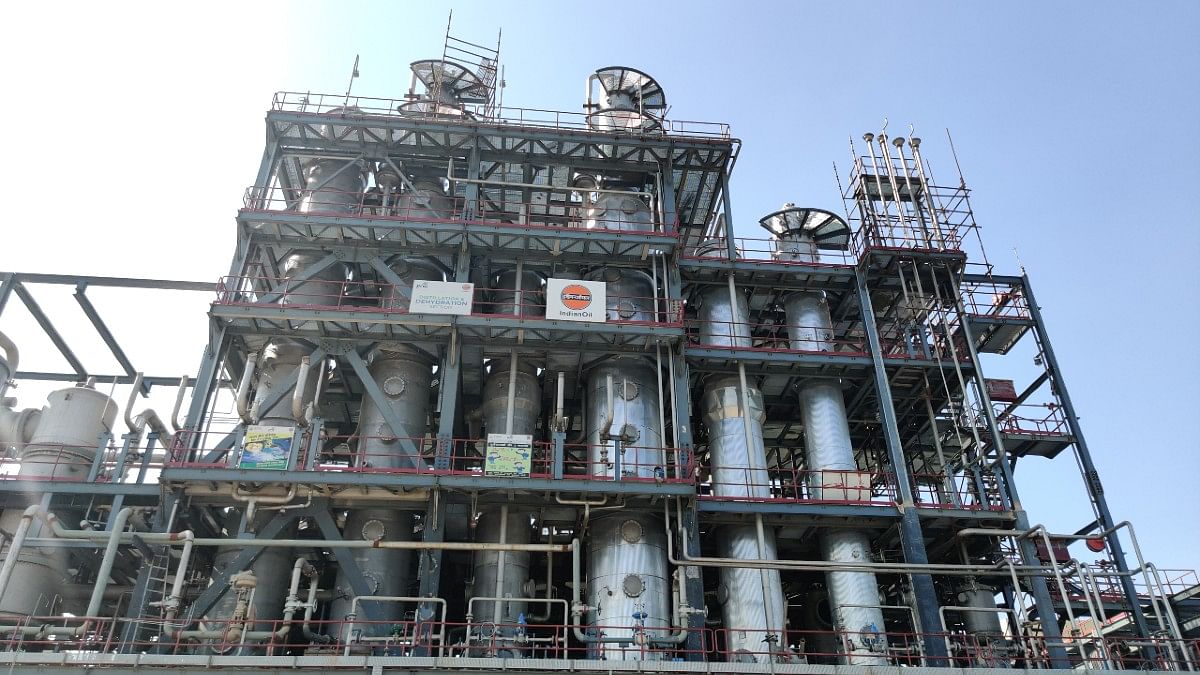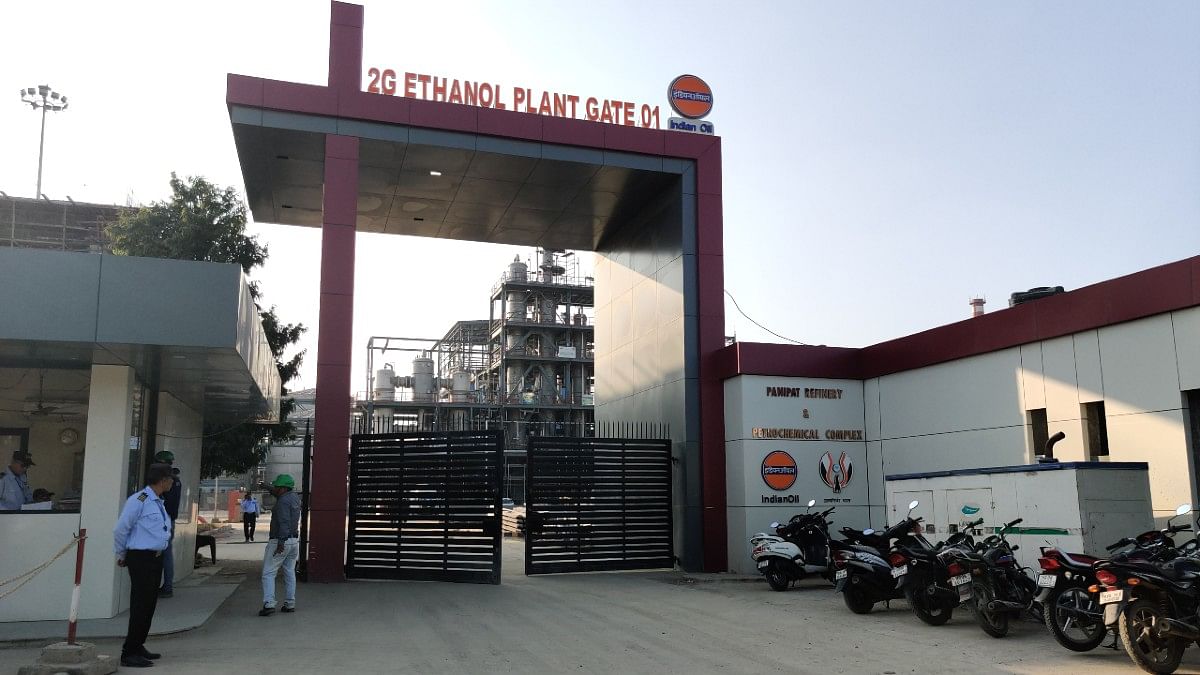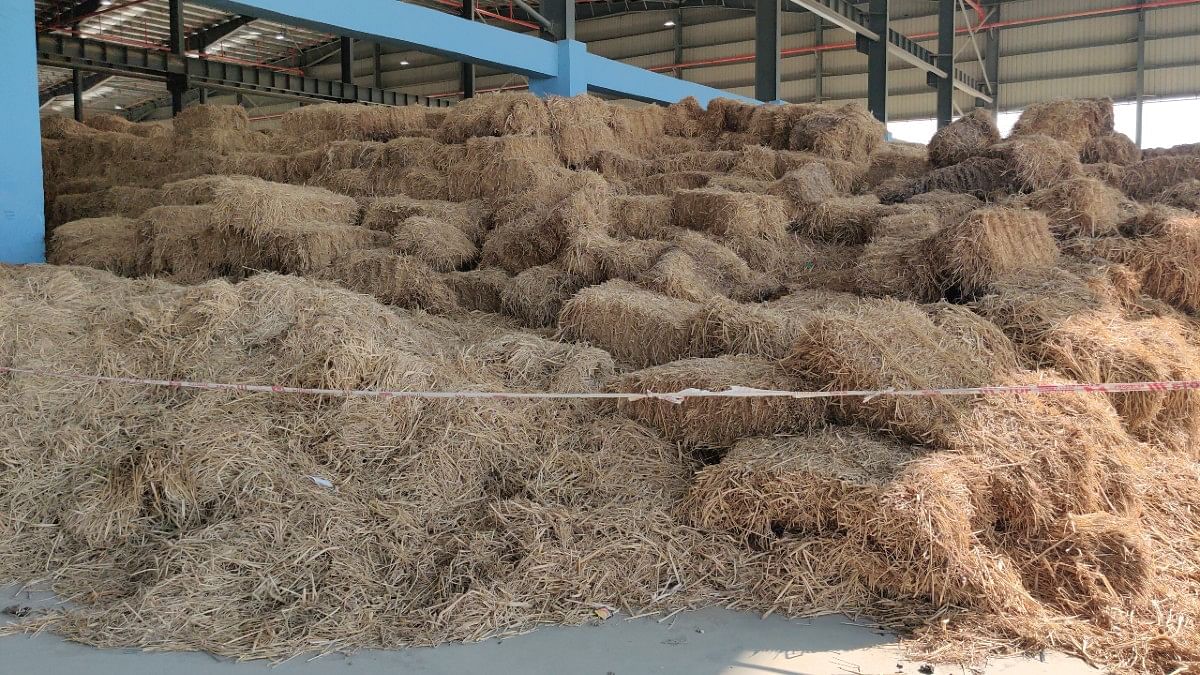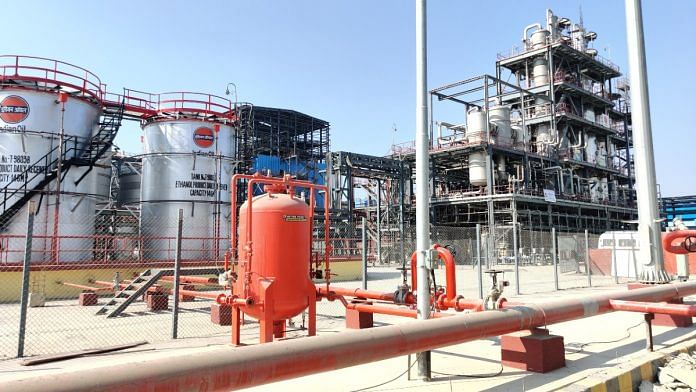Panipat: Can a public sector giant incentivise farmers to opt for alternative methods of stubble disposal, help marginally reduce India’s oil import bill, and prevent CO2 emissions to the extent that it may be the same as removing 62,000 cars from roads? The order may seem tall, but this is exactly what a central public sector enterprise (CPSE) — which happens to be a Fortune 500 oil company — has set out to do in Haryana’s Panipat.
Once commissioned next month, the Indian Oil Corporation Ltd’s (IOCL) 2G (second generation) ethanol plant in Panipat will process 2.1 lakh metric tonnes (MT) of dry rice straw annually, converting it into 3 crore litres of ethanol — a biofuel derived mainly from rice, corn and sugar. Most of this dry rice straw is burnt by farmers in Haryana and Punjab as they clear their fields for the next crop post-harvest.
Ethanol generated from processing the dry rice straw at this plant will then be blended with petrol (up to 10 per cent) and sold in the retail market by oil marketing companies.

On the air pollution front, though the 2G plant will not be enough to put a lid on carbon emissions, it will single handedly prevent about 3 lakh MT of CO2 emissions per annum from entering the environment, equivalent to removing 62,000 cars from Indian roads.
Coupled with a second 3G ethanol plant in the vicinity, which is in the process of being commissioned, the Panipat plant will contribute to reducing India’s net crude import bill in the long run, given that at present, almost 80 per cent of the crude processed in the country is imported.
To taper off the high crude bill, the government has been pushing for increased blending of ethanol, a plant-based fuel, with petrol. Under its Ethanol Blended Petrol programme, the Centre is targeting 20 per cent blending of ethanol with petrol by 2025.
This plant will be commissioned in the backdrop of India’s emphatic endorsement of renewable energy at the just-concluded United Nations’ Climate Change Conference (COP27) in Egypt’s Sharm el-Sheikh where developing and developed countries reached a landmark consensus on a loss and damage fund to help combat the effects of climate change.
Affirming that the 2G plant in Panipat is in the final stages of commissioning, IOCL chief general manager (projects) Joydeep Choudhury tells ThePrint: “It will take another month. We have done the trials. Only the fermentation and hydrolysis trial has to be done. We have not yet produced ethanol. It will start coming out by next month.”
The plant was dedicated to the country by Prime Minister Narendra Modi on 10 August.
For now, trial runs are underway at the plant where some 1,300 workers are toiling to wrap up the final leg of construction. Meanwhile, dry paddy straw or parali (stubble) to be used as feedstock for the plant, is being aggregated from villages within a 50 km radius of Panipat.
Also Read: India increases the rate for state-run fuel retailers to buy sugarcane-based ethanol
Mammoth scale of operation
Operating at full capacity, the plant in Panipat will require 2.1 lakh MT of rice straw each year to produce 3 crore litres of ethanol — roughly 100 kilo litres (1 kilo litre is 1,000 litres) per day.
IOCL officials believe they are unlikely to face a shortage of rice straw in this region, citing a government survey to say that rice straw production within a 50 km radius of the plant amounts to 8.9 lakh MT per annum. “Of that, we require only 2.1 lakh MT per annum,” said one of the officials.
Aggregating rice straw and transporting it to the plant is bound to be a mammoth operation.
From the time the rice straw is cut, to the time of baling, storage and transportation to the plant where it will be processed, a network of aggregators including farmer producer organisations (FPOs), truck drivers, depot managers and contractors will be on the job to manage the logistics.
The FPOs will coordinate with farmers to buy the feedstock and bring it to special depots where they will be baled (stacked in bundles) before being supplied to the plant in trucks. The operation will entail 80-100 trucks on average per day, with each truck carrying 8 MT of rice straw.
IOCL has outsourced the transportation of stubble from depots to the plant to local companies.

Upon reaching the plant, the rice straw will be stocked in a special earmarked storage area which, as of now, is big enough to stock two-day stock of rice straw. Once in the storage area, the rice straw will be sent for processing to different sections — milling, wet washing, pre-treatment, hydrolysis and fermentation.
M.L. Dahriya, executive director and refinery head at IOCL’s Panipat Refinery, said the Haryana government facilitated the process of getting FPOs together. “They have got all these FPOs together, they have also set the price farmers will get per ton of stubble that they supply, which otherwise, was worth nothing actually,” he told ThePrint.
Explaining how farmers were getting nothing in return for the stubble earlier, Dahriya said, “Now, the farmers will be paid a handsome sum of money for every tonne of paddy straw that they sell to IOCL.”
The IOCL will give FPOs Rs 1,800 per MT of rice straw. And the FPOs will in turn pay the farmers approximately Rs 1,000 per MT.
India’s share in global ethanol production
While the government is hoping for a 20 per cent blended fuel (ethanol blended with petrol) rollout in the market by April 2025, Choudhury said blended fuel is a relatively recent phenomenon in India.
In 2014, ethanol-blended petrol that was retailed by oil marketing companies stood at 1.4 per cent. Today, that figure stands at 10 per cent and the Centre — under its Ethanol Blended Petrol programme — hopes to achieve a 20 per cent blending of ethanol in petrol by 2025.
Several economies around the world are blending petrol or motor spirit with ethanol, with the US and Brazil contributing 92 billion litres or 84 per cent of the global share. India’s share is a minuscule 3 per cent.
According to Choudhury, India will need to produce 9 billion litres of ethanol each year by 2025 to achieve its goal of 20 per cent ethanol blending by 2025. As against this, India is now producing 5 billion litres of ethanol annually.
While the 2G plant in Panipat will generate ethanol from rice straw, a major chunk of ethanol generated in India is not a byproduct of paddy crops. “Sugarcane industry is the major contributor of ethanol in the country. It comes from the sugar industry, molasses. It’s what we call 1G (first generation) ethanol,” Choudhury pointed out.
What is 2G & why Panipat
Second generation (2G) is essentially technology wherein rice straw or wheat straw — a leftover part of the plant, not the grain — is taken and put through a process of hydrolysis and fermentation to generate ethanol.
Rice straw contains cellulose, hemicellulose and lignin. The lignin has to be separated during pre-treatment to ensure the availability of hemicellulose and cellulose for hydrolysis, which is done in the presence of enzymes to convert the cellulose and hemicellulose into sugar.
The sugar is then forwarded to the fermentation section where it is fermented in the presence of yeast to produce 2 per cent ethanol which then goes to the distillation and dehydration section, where water is removed to get 98.6 per cent ethanol. This ethanol then goes to storage tanks before being routed to the blending area, where it is blended with petrol.
Spread over an area of 35 acres, the 2G plant in Panipat is situated on the Punjab-Haryana rice belt. The region has an abundance of rice, which is grown only once a year and harvested in September and October. Once harvested, the rice straw is bailed using baling machines.
Explaining why farmers burn dry rice straw, an official at the IOCL 2G plant told ThePrint: “Now, if you look at the harvester machines presently used to harvest the crop, it leaves 8-10 inches of stubble still above the soil. It cuts from above that level. Taking this stubble out is very tedious work for the farmers and then once they take that out, they have to again worry about its disposal. So, the easiest way out for them is to set it to fire.”
This practice of burning dry rice straw accelerates air pollution levels in the National Capital Region (NCR) year after year. “With this 2G plant, the government is basically incentivising the farmers, saying don’t burn the stubble,” the official added.
Besides the IOCL plant in Panipat, Bharat Petroleum Corporation Ltd (BPCL) is setting up an integrated 2G and 1G bioethanol refinery in Odisha’s Bargarh, Hindustan Petroleum Corporation Ltd (HPCL) a bio-ethanol plant in Punjab’s Bathinda and Mangalore Refinery and Petrochemicals Ltd (MRPL) a 2G ethanol plant in Karnataka’s Davanagere.
Challenges — logistics, land acquisition
Regarding the 2G plant in Panipat, IOCL officials say logistics and land acquisition are among the biggest challenges facing them.
“The challenge is not the availability of rice straw. The challenge is the logistics. There is a lot of manual handling, warehousing, and transportation. We are looking at a huge volume and it is not something that can be pumped through a pipeline like crude,” said one official.
“The feedstock is seasonal and has to be stocked for the entire year. You need to purchase during those two months and stock for the rest of the year,” said Dahriya, referring to the pre-harvest period of 15-20 days in September-October each year when the rice straw is aggregated.
Getting space to store the rice straw is another big challenge.
To stock one year of feedstock, IOCL will require anywhere between 150-200 acres of land. “Getting the land is slightly problematic but that will be sorted out. We have asked the Haryana government for 100 acres of land for storing 1 lakh MT of rice straw. So far, they have handed over three segments of the land of around 56 acres,” said Dahriya.

In addition to the space it has to store 40,000 MT of dry rice straw inside the plant, IOCL has also set up three depots outside the plant for this purpose.
‘Not profitable just yet’
From a purely business point of view, 2G ethanol is not a profitable enterprise just yet.
“It will be profitable only when what you are blending (ethanol) is less than the cost of your product (petrol). At this point, that equation is not very favourable. The cost of ethanol that is blended in petrol is more than the cost at which petrol is sold,” said the IOCL official quoted earlier.
But the IOCL is not looking at the Panipat project through the prism of profit.
“It is one step towards IOCL migrating from pure hydrocarbons to ethanol. The other objective is to incentivise the farmers so that they don’t burn the stubble and cause pollution, Choudhury said.
(This is an updated version of the copy)
(Edited by Amrtansh Arora)
Also Read: Does India have enough rice for welfare schemes and ethanol? What the govt is missing



